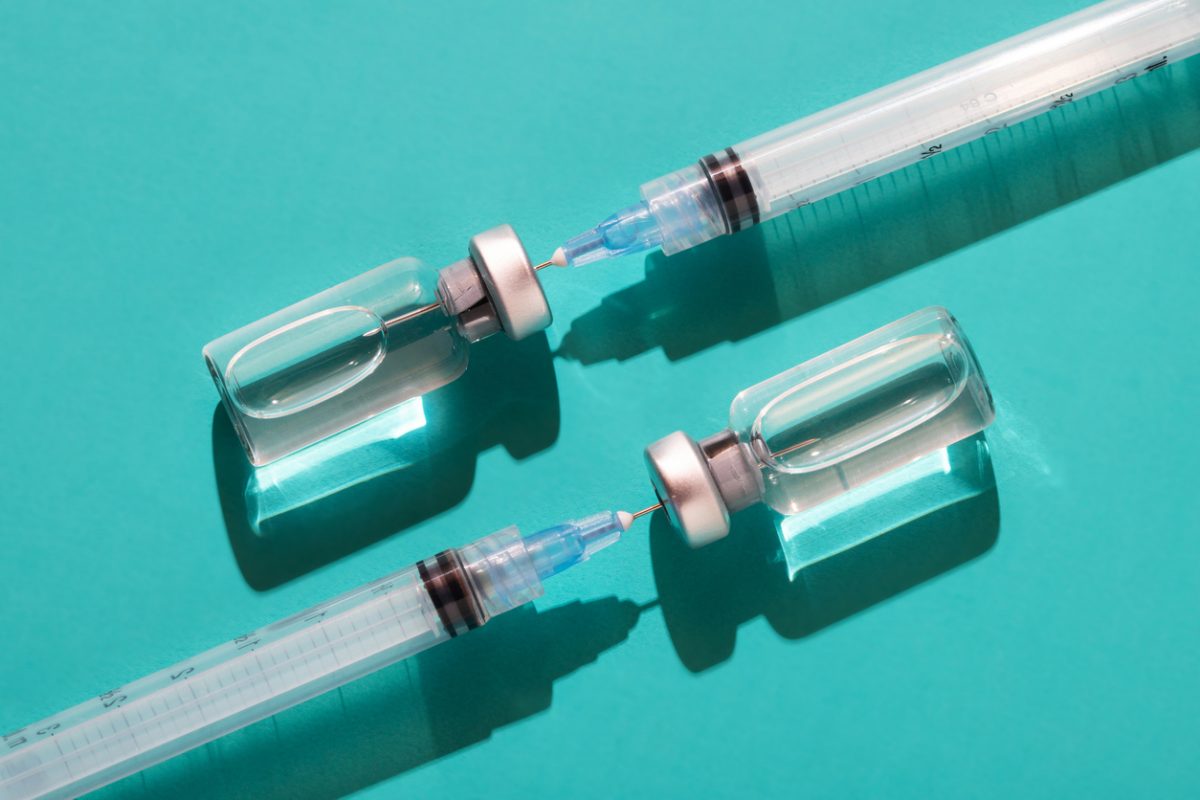Background: Valbenazine, a highly selective vesicular monoamine transporter 2 inhibitor, is approved for the treatment of tardive dyskinesia. This is the first report of long-term effects in adults with tardive dyskinesia.
Methods: Participants with a DSM-IV diagnosis of schizophrenia, schizoaffective disorder, or a mood disorder who completed the 6-week, double-blind, placebo-controlled period of KINECT 3 were eligible to enter the 42-week valbenazine extension (VE) period and subsequent 4-week washout period. The extension phase was conducted from December 16, 2014, to August 3, 2016. Participants who received placebo and entered the VE period were re-randomized 1:1 to valbenazine 80 or 40 mg while others continued valbenazine at the KINECT 3 dose. Safety assessments included treatment-emergent adverse events (TEAEs) and scales for suicidal ideation/behavior, treatment-emergent akathisia or parkinsonism, and psychiatric symptoms. Efficacy assessments included the Abnormal Involuntary Movement Scale (AIMS) and Clinical Global Impression of Change-Tardive Dyskinesia (CGI-TD).
Results: 198 participants entered the VE period, 124 (62.6%) completed treatment (week 48), and 121 (61.1%) completed the follow-up visit after washout (week 52). During the VE period, 69.2% of participants had ≥ 1 TEAE, 14.6% had a serious TEAE, and 15.7% discontinued due to a TEAE. During washout, 13.1% of participants experienced a TEAE. No apparent risk for suicidal ideation or behavior was found. Long-term valbenazine treatment did not appear to induce or worsen akathisia or parkinsonism. Participants generally remained psychiatrically stable during the study. AIMS and CGI-TD measures indicated sustained tardive dyskinesia improvement, with scores returning toward baseline after 4 weeks of valbenazine washout.
Conclusions: The long-term safety and tolerability of valbenazine were generally favorable, and maintenance of treatment effect was apparent with both doses during this long-term study.
Trial Registration: ClinicalTrials.gov identifier: NCT02274558
The Effects of Valbenazine in Participants with Tardive Dyskinesia:
Results of the 1-Year KINECT 3 Extension Study
ABSTRACT
Background: Valbenazine, a highly selective vesicular monoamine transporter 2 inhibitor, is approved for the treatment of tardive dyskinesia. This is the first report of long-term effects in adults with tardive dyskinesia.
Methods: Participants with a DSM-IV diagnosis of schizophrenia, schizoaffective disorder, or a mood disorder who completed the 6-week, double-blind, placebo-controlled period of KINECT 3 were eligible to enter the 42-week valbenazine extension (VE) period and subsequent 4-week washout period. The extension phase was conducted from December 16, 2014, to August 3, 2016. Participants who received placebo and entered the VE period were re-randomized 1:1 to valbenazine 80 or 40 mg while others continued valbenazine at the KINECT 3 dose. Safety assessments included treatment-emergent adverse events (TEAEs) and scales for suicidal ideation/behavior, treatment-emergent akathisia or parkinsonism, and psychiatric symptoms. Efficacy assessments included the Abnormal Involuntary Movement Scale (AIMS) and Clinical Global Impression of Change-Tardive Dyskinesia (CGI-TD).
Results: 198 participants entered the VE period, 124 (62.6%) completed treatment (week 48), and 121 (61.1%) completed the follow-up visit after washout (week 52). During the VE period, 69.2% of participants had ≥ 1 TEAE, 14.6% had a serious TEAE, and 15.7% discontinued due to a TEAE. During washout, 13.1% of participants experienced a TEAE. No apparent risk for suicidal ideation or behavior was found. Long-term valbenazine treatment did not appear to induce or worsen akathisia or parkinsonism. Participants generally remained psychiatrically stable during the study. AIMS and CGI-TD measures indicated sustained tardive dyskinesia improvement, with scores returning toward baseline after 4 weeks of valbenazine washout.
Conclusions: The long-term safety and tolerability of valbenazine were generally favorable, and maintenance of treatment effect was apparent with both doses during this long-term study.
Trial Registration: ClinicalTrials.gov identifier: NCT02274558
J Clin Psychiatry
https://doi.org/10.4088/JCP.17m11777
© Copyright 2017 Physicians Postgraduate Press, Inc.
aDepartment of Neurology, Emory University School of Medicine, Atlanta, Georgia
bSchizophrenia Division, Centre for Addiction and Mental Health, Toronto, Ontario, Canada
cDepartment of Neurological Sciences, Rush University Medical Center, Chicago, Illinois
dDepartment of Psychiatry and Molecular Medicine, Hofstra Northwell School of Medicine, New York, New York
eNeurocrine Biosciences, Inc, San Diego, California
*Corresponding author: Stewart A. Factor, DO, Emory University School of Medicine, Department of Neurology, 12 Executive Park Dr NE, Room 284, Atlanta, GA 30329 ([email protected]).
Tardive dyskinesia (TD) is a persistent, often disabling, and potentially irreversible movement disorder that has been associated with exposure to dopamine receptor blocking agents (DRBAs) such as antipsychotics.1–3 Evidence suggests that DRBAs up-regulate postsynaptic dopamine receptors, resulting in hypersensitivity and increased dopamine signaling, which in turn, leads to TD.4 Other pathogenetic hypotheses include GABAergic neuron dysfunction, synaptic plasticity dysfunction, or neurotransmitter system degeneration, which may also contribute to TD by altering basal ganglia pathways or neurons.5 Even with the advent of atypical antipsychotics, which were developed to lower the risk of side effects including TD, TD has remained an important clinical problem.6–9 The first practical step for treating TD is dose reduction or discontinuation of the antipsychotic. Often, however, this is not possible without exacerbation of the psychiatric disorder.10 Medications such as clozapine, baclofen, tetrabenazine, and benzodiazepines have been anecdotally reported to improve TD, but evidence for their efficacy is limited.10
Valbenazine, a novel and highly selective vesicular monoamine transporter 2 (VMAT2) inhibitor, is approved by the US Food and Drug Administration (FDA) for treatment of TD in adults. On the basis of its pharmacologic profile,11 it is hypothesized that the inhibitory effects of valbenazine may diminish monoamine neurotransmitter concentrations in the synaptic cleft, thereby reducing the availability of dopamine to hypersensitive postsynaptic receptors and reducing TD.12
In two 6-week, double-blind, placebo-controlled (DBPC) clinical trials (KINECT 2, NCT01733121; KINECT 3, NCT02274558),13,14 treatment with once-daily valbenazine resulted in significant improvement of TD compared to placebo. Short-term treatment with valbenazine was generally well tolerated, and stable psychiatric status was maintained in both DBPC studies. KINECT 3 was designed also to include a 42-week treatment extension period for evaluating the long-term safety and tolerability of valbenazine at doses of 40 and 80 mg/d, along with its long-term effectiveness on TD. The current article reports the results from this extension period.
METHODS
Study Design and Participants
KINECT 3 included a 6-week DBPC period, followed by a 42-week blinded valbenazine extension (VE) period and a 4-week washout period, with final follow-up at week 52 (see Supplementary eFigure 1 at PSYCHIATRIST.COM). Detailed methods for the DBPC portion of KINECT 3 have been reported previously.14 The study protocol was approved by the institutional review board for each site. The study was conducted in accordance with International Conference on Harmonization Guidelines for Good Clinical Practice, US Code of Federal Regulations standards, FDA guidelines, and the Health Canada Guidance for Clinical Trial Sponsors. Only individuals with the capacity to provide consent (using the University of California, San Diego Brief Assessment of Capacity to Consent) were allowed to participate.
Participants who completed the 6-week DBPC period and re-consented to entering the VE period received valbenazine 40 or 80 mg/d. Participants already receiving either valbenazine dose continued the same dose; those receiving placebo were randomized (1:1) to valbenazine 40 or 80 mg/d, with all dosing started at 40 mg/d and increased to 80 mg/d after the first week (in the group randomized to this dose). Participants were allowed 1 dose reduction during the study with blinding maintained, as previously reported.14
Key inclusion criteria for KINECT 3 were as follows: medically stable men and women with a Diagnostic and Statistical Manual of Mental Disorders, Fourth Edition (DSM-IV) diagnosis of schizophrenia, schizoaffective disorder, or a mood disorder; moderate or severe TD based on the qualitative assessment of screening Abnormal Involuntary Movement Scale (AIMS)15 videos by external AIMS reviewers; and stable psychiatric status at screening. Stable doses of concomitant medications to treat existing psychiatric disorders were allowed throughout the study. Exclusion criteria included comorbid movement disorder that was more prominent than TD (eg, parkinsonism, akathisia, truncal dystonia) and significant risk for active suicidal ideation, suicidal behavior, or violent behavior.
Safety Analyses
All participants who entered the VE period were included in the safety analyses. All safety data were analyzed descriptively. Safety assessments included treatment-emergent adverse events (TEAEs), vital signs, 12-lead electrocardiogram (ECG), and laboratory assessments. Emergence of suicidal ideation or behavior was monitored using the Columbia-Suicide Severity Rating Scale (C-SSRS). The Barnes Akathisia Rating Scale (BARS) and Simpson-Angus Scale (SAS) were used to evaluate for treatment-emergent akathisia and parkinsonism, respectively. Psychiatric status was monitored using the Positive and Negative Syndrome Scale (PANSS) and Calgary Depression Scale for Schizophrenia (CDSS) in participants with schizophrenia or schizoaffective disorder and the Young Mania Rating Scale (YMRS) and Montgomery-Asberg Depression Rating Scale (MADRS) in participants with mood disorder.
Efficacy Analyses
Although the primary aim of the VE period was to evaluate long-term safety, the long-term effects of valbenazine on TD were also assessed using the AIMS, the Clinical Global Impression of Change-Tardive Dyskinesia (CGI-TD), and the Patient Global Impression of Change (PGIC).15 These analyses included all participants who entered the VE period. All participants, investigators, and central AIMS video raters were blinded to dose assignments during the VE period.
As in the DBPC period, all AIMS scoring in the VE period was based on the consensus of 2 central AIMS video raters who were blinded to study visit (as well as to treatment dose), including the week 52 follow-up visit. For the AIMS score, defined as the sum of scores from items 1–7, changes from baseline were analyzed by study visit (weeks 8, 16, 32, 48, and 52) using arithmetic means based on observed cases. Post hoc analyses were also conducted to calculate the mean percent change for the AIMS score from baseline to week 48 and to determine whether mean changes in AIMS score at week 48 were statistically significant compared to the DBPC baseline. Both post hoc analyses were conducted in participants with an available AIMS score at the first visit in the VE period (week 8) using a last observation carried forward approach. Significance for the mean change in AIMS score was analyzed using 2-sided P values from a 1-sample t test.
CGI-TD and PGIC mean scores were also analyzed, as were AIMS response (≥ 50% score reduction from baseline), CGI-TD response (rating of 1 [very much improved] or 2 [much improved]), and PGIC response (rating of 1 [very much improved] or 2 [much improved]). Worsening was also analyzed using the AIMS (≥ 50% score increase from baseline) as well as CGI-TD and PGIC (both, rating of 6 [much worsened] or 7 [very much worsened]). Per the approved protocol, this study was not designed to test for statistical significance between the valbenazine dose groups, partly because participants were allowed 1 dose reduction during treatment.
RESULTS
Participants
Of the 205 participants who completed the DBPC period, 198 (96.6%) entered the VE period (80 mg/d, n = 101 [36 from placebo]; 40 mg/d, n = 97 [33 from placebo]) (Supplementary eFigure 2). One hundred twenty-four (62.6%) participants completed the VE period, and 121 (61.1%) completed washout and had a follow-up visit at week 52. The most common reasons for study discontinuation were adverse events (15.7%), withdrawal of consent (8.6%), and loss to follow-up (7.1%). Demographic and clinical characteristics of participants in the VE period were similar between treatment groups (Table 1).
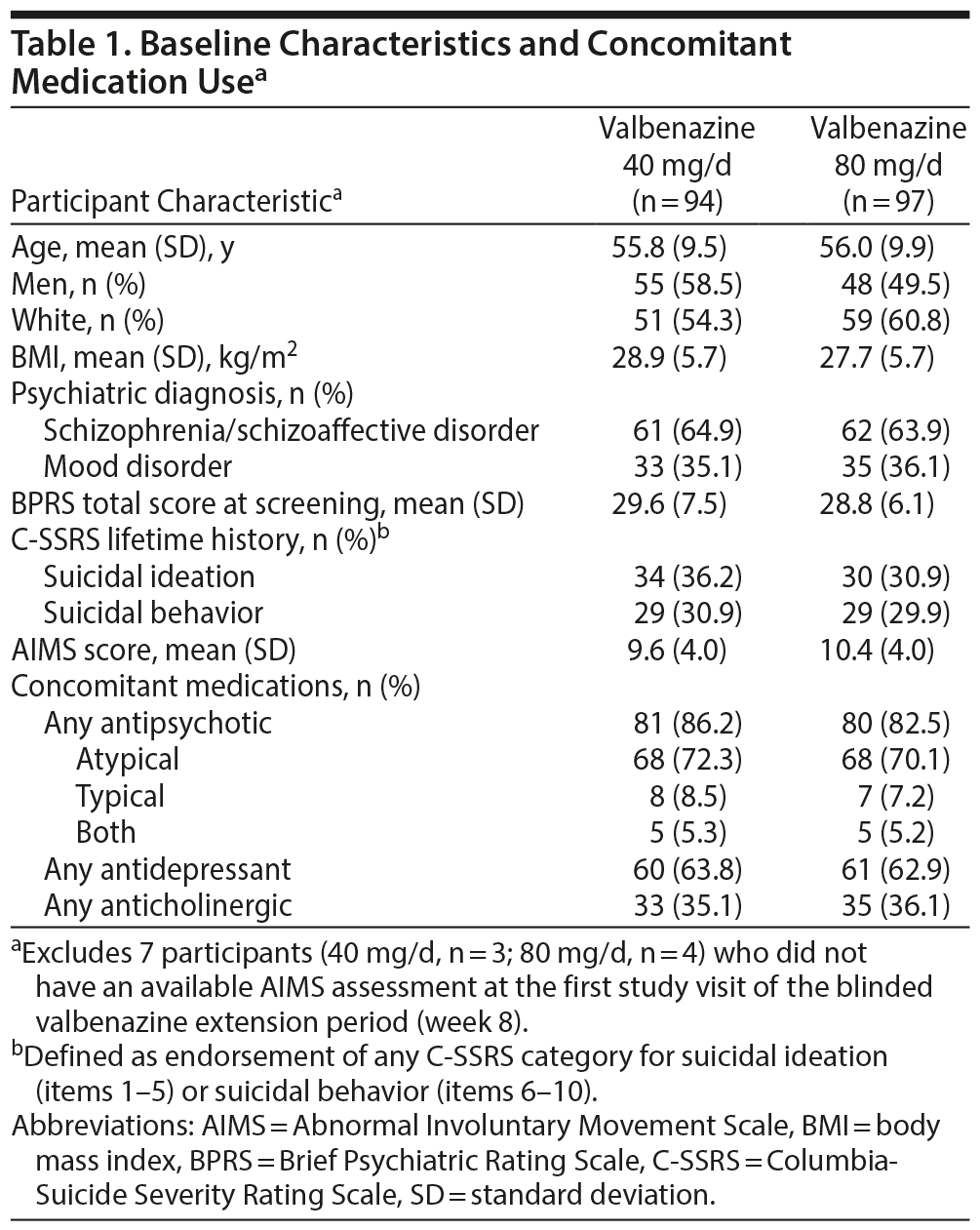
Safety
During the VE period, 69.2% of participants had ≥ 1 TEAE (Table 2). The only TEAEs leading to study discontinuation in > 2 participants were somnolence (80 mg/d, n = 3) and suicidal ideation (80 mg/d, n = 1; 40 mg/d, n = 2). A description of the 3 participants who were discontinued from the study for suicidal ideation, along with discontinuations due to suicidal behavior or suicidal attempt (1 participant each), is provided in eAppendix 1. These cases of suicidal ideation or behavior/attempt all resolved with hospitalization/medical management and were judged by the site investigators as unlikely related or unrelated to valbenazine. Few participants had worsening of C-SSRS suicidal ideation (Supplementary eTable 1), despite 33.5% (64/191) and 30.4% (58/191) of participants having a lifetime history of suicidal ideation and behavior, respectively (Table 1).
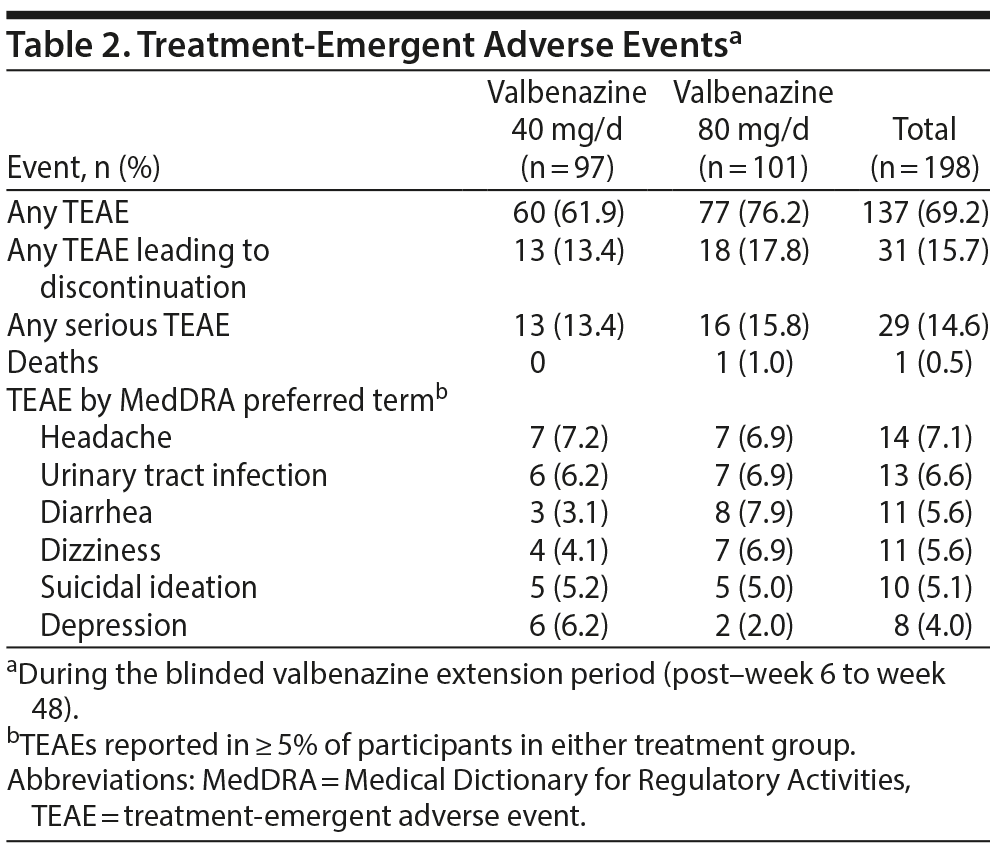
The incidence of serious TEAEs was 14.6% in the VE period. Syncope was the only serious TEAE reported in > 2 participants (80 mg/d, n = 1; 40 mg/d, n = 2). One death occurred in a 59-year-old man (80 mg/d) who experienced hyperkalemia, cardiac failure, hepatic failure, diabetes mellitus, metabolic acidosis, and pleural effusion. The site investigator assessed the death as not related to valbenazine.
During washout (weeks 48 to 52), 16 participants (13.1%) experienced a TEAE. The only TEAE reported in ≥ 2 participants was anxiety (80 and 40 mg/d, n = 1 each). TD was not reported as an AE during this period. No participants were discontinued during the washout period due to a TEAE. Three participants experienced a serious TEAE: 1 with head injury and limb amputation, 1 with delirium, and 1 with hypertension; all serious TEAEs were judged by site investigators as not related to study medication.
There were no clinically important changes in clinical laboratory, vital signs, or ECG parameters during the VE or washout periods.
Mean changes from baseline in BARS and SAS scores were generally minimal and not clinically significant, indicating that valbenazine treatment did not induce or worsen akathisia or parkinsonism (Supplementary eTable 2). These findings were consistent with the few TEAE reports for akathisia (2 participants, both 40 mg/d) and parkinsonism (1 participant, 80 mg/d). Mean scores for psychiatric scales (PANSS, CDSS, YMRS, MADRS) generally remained stable during long-term valbenazine treatment and after washout (Supplementary eTable 2).
Efficacy
TD improvement with valbenazine, as measured by the AIMS score, was sustained throughout the VE period (Figure 1). At week 48, mean changes in AIMS score were −4.8 (80 mg/d) and −3.0 (40 mg/d), representing statistically significant improvements relative to baseline in both dose groups (Figure 1A; P < .001). Similar results were found in the analysis based on original DBPC treatment assignment, including the groups who were switched from placebo to active drug (Figure 1B). At week 48, mean percent improvements from baseline in AIMS score were 39.4% (80 mg/d) and 23.7% (40 mg/d). AIMS scores increased from week 48 to week 52, indicating that TD returned toward baseline levels during the 4-week period following discontinuation of valbenazine.
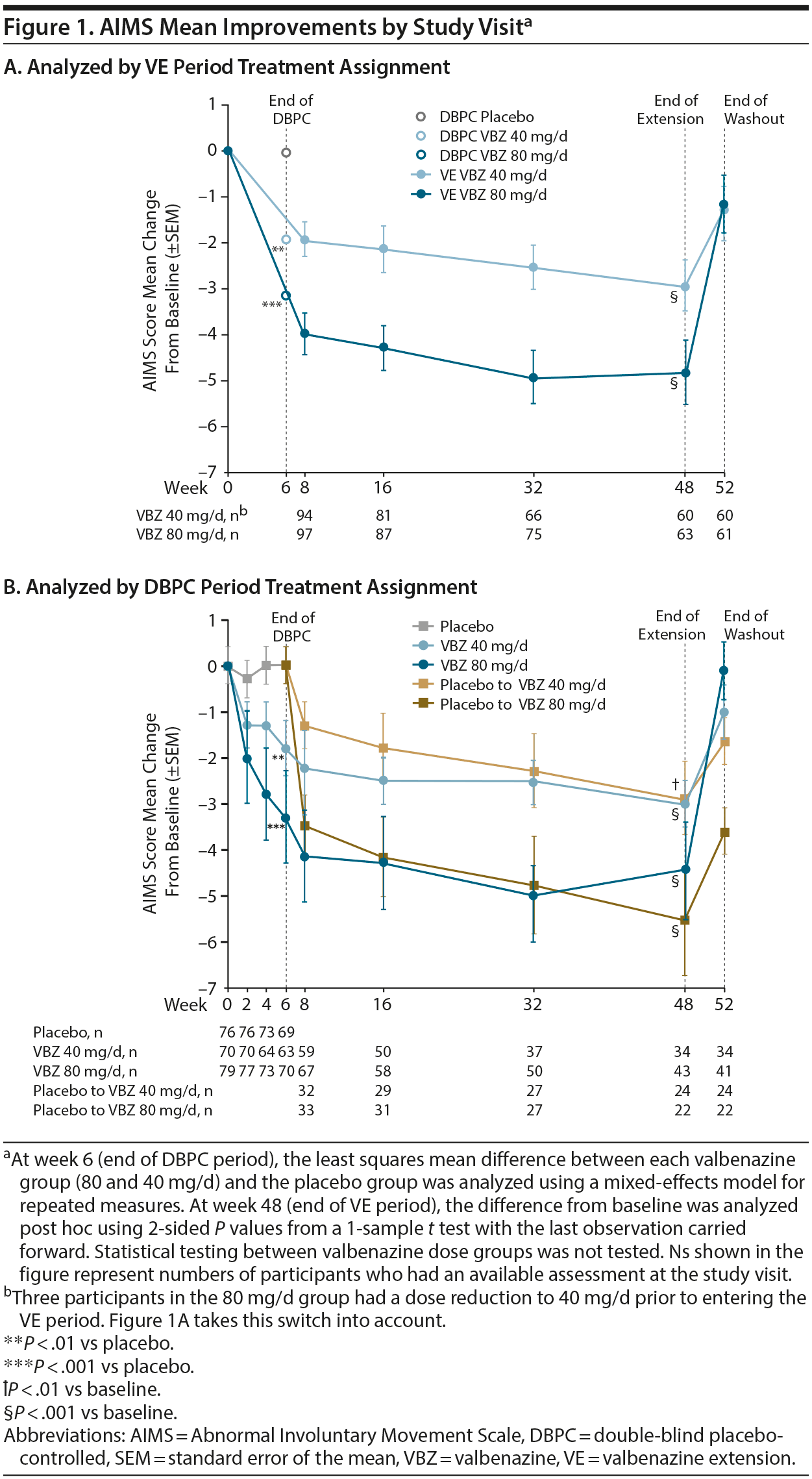
CGI-TD mean scores demonstrated clinically meaningful global improvements during long-term treatment with valbenazine, with lower mean scores (ie, more improved) at week 48 (80 mg/d, 2.1; 40 mg/d, 2.4) than at week 52 (80 mg/d, 3.5; 40 mg/d, 3.1), suggesting a return toward baseline severity of TD during washout (Figure 2). For the PGIC, there was a similar pattern of clinical improvement during valbenazine treatment, with lower (ie, more improved) mean scores at week 48 (80 mg/d, 2.0; 40 mg/d, 2.2) than week 52 (80 mg/d, 3.1; 40 mg/d, 2.6).

Response rates during the VE period were generally consistent across study visits for AIMS (Figure 3A) and increased steadily across study visits for CGI-TD (Figure 3B) and PGIC (Figure 3C). For AIMS response (≥ 50% score improvement from baseline) and CGI-TD response (rating of “much improved” or “very much improved”), response rates were lower after washout (weeks 48 to 52) than during the VE period (weeks 8 to 48). For PGIC response (rating of “much improved” or “very much improved”), the rate was lower at week 52 than at weeks 32 and 48. Approximately 5% of subjects had > 50% worsening in AIMS total score during the VE period, although CGI-TD and PGIC scores at week 48 indicated that only 1 participant was “much worse” or “very much worse” (per investigator judgment) after long-term treatment (Supplementary eTable 3).
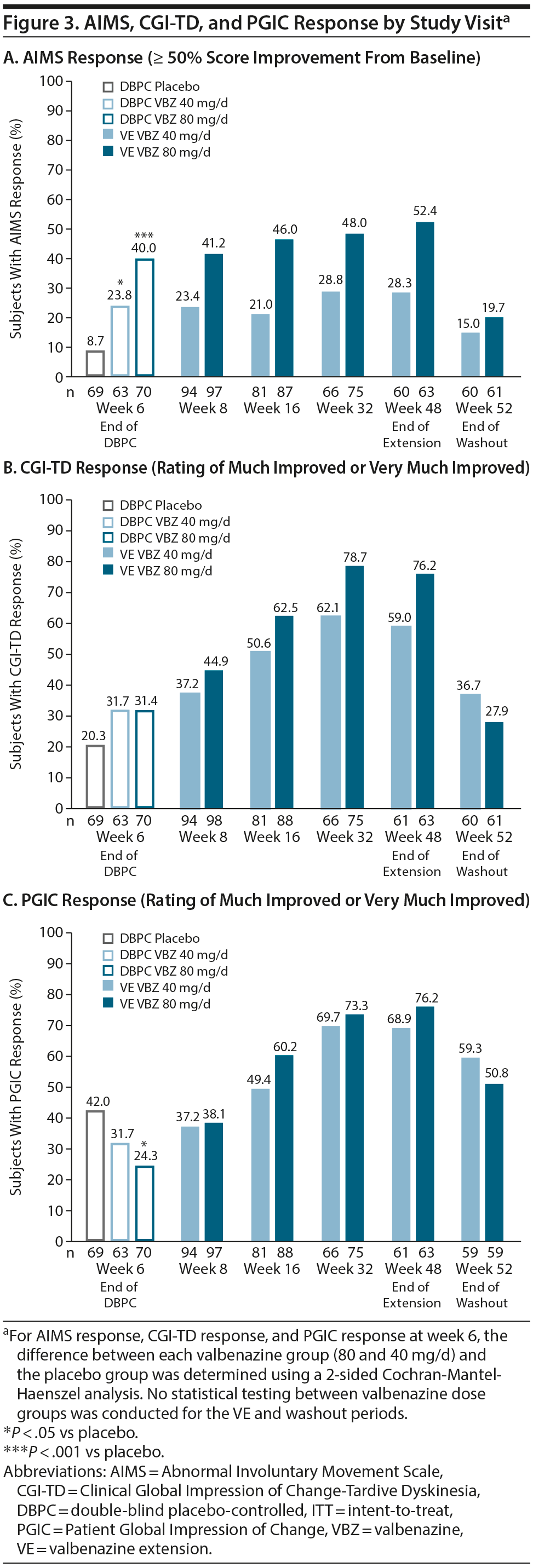
DISCUSSION
This is the first study to report the safety and effectiveness of long-term valbenazine treatment in TD. Results of this extension study generally indicated that valbenazine was safe and well tolerated, and maintenance of treatment effect was apparent for both doses (80 and 40 mg/d).
No unexpected TEAEs were found in the VE period. The 2 most common were headache and urinary tract infection (7.1% and 6.6% of all participants, respectively), neither of which was dose-related or led to premature discontinuation from the study. Few participants were discontinued due to suicidal ideation (1.5%), suicidal behavior (0.5%), or suicidal attempt (0.5%), which was consistent with the incidence of serious suicidal ideation and behavior (1% each) found in the Clinical Antipsychotic Trials of Intervention Effectiveness study that examined the safety and efficacy of various antipsychotics in patients with chronic schizophrenia.16 In addition, the TEAE incidence of any suicidal ideation (5.1% of all participants, 5 in each valbenazine dose group) and the percentage of participants with any worsening from baseline in C-SSRS score (6.7%) were similar to the TEAE incidence of suicidal ideation in the placebo group during the 6-week DBPC period (5.3%). Given the fact that approximately 30% of participants in this study had a lifetime history of suicidal ideation and/or behavior, this 5% incidence of suicidal ideation in the long-term valbenazine treatment groups was not surprising. As is recommended for all patients with increased risk for suicide,17,18 treatment with valbenazine may require regular monitoring of suicide-related thoughts and behaviors. Other VMAT2 inhibitors, tetrabenazine and deutetrabenazine, carry boxed warnings for depression and suicidality in patients with Huntington’s disease.19,20 However, valbenazine is not considered to increase the risk of suicidal ideation or behavior in patients with TD.21
All participants were deemed psychiatrically stable by the site investigator prior to entering KINECT 3. Stable doses of concomitant psychiatric medications, including antipsychotics, were permitted for management of their psychiatric diagnoses. As indicated by mean score changes in the PANSS, CDSS, YMRS, and MADRS, the psychiatric status of participants generally remained stable during the VE and washout periods, indicating that the effects of valbenazine on TD did not interfere with the antipsychotic and/or antidepressant effects of concomitant medications. Depression was reported as a TEAE in 8 participants during the VE period, more commonly in the 40 mg/d group (6.2%) than in the 80 mg/d group (2.0%). Five of these participants had a primary mood disorder, and 2 with schizophrenia or schizoaffective disorder had a history of depression. All cases were categorized as mild or moderate, and none resulted in premature discontinuation.
Antipsychotic medications have been associated with metabolic side effects, ECG and cardiovascular irregularities, and treatment-emergent extrapyramidal symptoms,22–24 and approximately 85% of participants in KINECT 3 were taking at least 1 antipsychotic. Therefore, an important aim of this study was to explore whether any of these safety parameters worsened during long-term valbenazine treatment. No clinically significant changes in laboratory parameters, vital signs, weight, or ECG parameters were found in the VE period. Mean changes from baseline in the BARS total and SAS global scores, along with the low incidences of movement disorder–related TEAEs in all participants (dyskinesia, 1.5%; akathisia, 1.0%; parkinsonism, 0.5%; extrapyramidal disorder, 0.5%) indicated that valbenazine did not aggravate TD or induce other movement disorders.4
The efficacy of valbenazine as compared to placebo was demonstrated in the 6-week DBPC period of KINECT 3.14 The VE period of KINECT 3 did not include a placebo group, and the primary aim of the extension period was to evaluate the long-term safety and tolerability of valbenazine in adults with TD. However, mean changes in AIMS score during this period indicated that TD improvements were sustained. AIMS scores demonstrated significant differences at end of treatment (week 48) versus DBPC baseline in both dose groups (P < .001) with a clear dose response trend. Similar results were found when AIMS score changes were analyzed by DBPC treatment assignment (ie, in participants switched from placebo and in participants who continued on valbenazine). At the follow-up visit that was conducted 4 weeks after valbenazine washout (week 52), AIMS mean scores were found to have increased toward baseline levels, suggesting that ongoing valbenazine treatment may be required to maintain TD improvements.
Complementary results were found with mean CGI-TD and PGIC scores, both of which indicated sustained TD improvements during long-term valbenazine treatment (week 48) and worsening of TD after valbenazine was discontinued (week 52). Both measures suggested a progression of improvement over time. Reasons for this trend are speculative, but contributing factors may include participants dropping out due to lack of efficacy; clinicians and participants accounting for factors beyond abnormal movements, such as quality of life or improved social functioning; clinicians and participants knowing how long they had been on valbenazine treatment (as compared to central AIMS raters who were blinded to study visit); and fewer adverse effects over time (ie, transience of TEAEs). It should also be noted that CGI-TD scores were based on the qualitative assessment of onsite study investigators who were blinded to dose assignment, but not study visit. PGIC scores were based on the qualitative assessments of study participants. More research is needed to better understand how scales like the AIMS might correlate with qualitative or global assessments from physicians, patients, and caregivers.
Response analyses for the AIMS (≥ 50% score reduction from baseline), as well as for CGI-TD and PGIC (score ≤ 2 for both measures), were conducted to determine the percentage of participants who experienced specific degrees of improvement during long-term valbenazine treatment. Consistent with analyses based on mean scores, response analyses showed sustained improvement during long-term treatment and a return toward baseline TD severity after valbenazine was discontinued. However, 17.4% of participants maintained an AIMS response at week 52 (ie, 4 weeks after treatment was discontinued), which seems consistent with a study of TD (primarily in nonpsychotic patients) that found 13% of cases to be reversible after the TD-offending medication was discontinued.3 More research, however, is needed to better understand the reversibility of TD and the potential for symptom remission.
The AIMS analysis of worsening in TD (≥ 50% score increase from baseline) showed that some participants did not improve during long-term treatment with valbenazine (week 48). After the 4-week washout period (week 52), however, more participants had demonstrated worsening in abnormal movements. Results from the CGI-TD and PGIC analyses (score ≥ 6) indicate that in this context of an open-label treatment discontinuation at the end of a clinical trial, clinician and patient perceptions of worsening were corroborated by increases in abnormal involuntary movements, as assessed by blinded central video raters using the AIMS.
As with most extension studies, interpretation of the efficacy results is limited by the absence of a placebo control. Interpretation is also limited by the current lack of guidelines or standards for clinical relevance (eg, minimal clinically important difference for the AIMS; adequate thresholds of response for AIMS, CGI-TD, and PGIC) and other long-term clinical trials in patients with TD. However, a randomized, placebo-controlled, withdrawal study is being planned, and the results of this future study should provide more definitive information about maintenance of treatment effect with valbenazine, as well as loss of effect. Results of other ongoing studies (52-week KINECT 4 study [NCT02405091], 72-week rollover study [NCT02736955]) are also expected to shed more light on the long-term effects of valbenazine on TD. Other important topics for future research include the time course of treatment response for valbenazine; characterization of early responders and time to onset of clinically meaningful treatment effect; and the effects of stopping, starting, and changing concomitant medications (eg, antipsychotics, anticholinergics) during real-world treatment with valbenazine.
In conclusion, long-term treatment with once-daily valbenazine at 80 or 40 mg/d was generally well tolerated in participants with TD regardless of concomitant psychiatric medication or underlying psychiatric diagnoses. Results indicated that many participants had sustained TD improvements during long-term treatment, with some return toward baseline severity after valbenazine was discontinued. Further research is needed to better understand the long-term effects of valbenazine on TD and to identify the types of patients who might benefit most from this novel medication.
Submitted: June 30, 2017; accepted October 11, 2017.
Published online: November 14, 2017.
Potential conflicts of interest: Dr Factor has received honoraria from Neurocrine Biosciences, Lundbeck, Auspex/Teva, Avanir, Cynapsus, Adamas, and UCB; grants from Ipsen, Medtronics, Teva, US World Meds, Pharm-Olam, Cynapsus Therapeutics, Solstice, Vaccinex, CHDI Foundation, Michael J. Fox Foundation, and National Institutes of Health (NIH); and royalties from Blackwell Futura, Demos, and UpToDate. Dr Remington has received consultant fees from Neurocrine Biosciences and Synchroneuron, program support from Novartis, and external funding from the Canadian Institutes of Health Research. Dr Comella serves on the editorial boards of Clinical Neuropharmacology, Sleep Medicine, and Continuum; receives research support from the NIH (R01NS074343, U54NS065701), Dystonia Medical Research Foundation, Allergan, Ipsen, Merz, and Biotie; receives compensation/honoraria for services as a consultant or an advisory committee member from Acorda Therapeutics, Allergan, Ipsen, Lundbeck, Medtronic, Merz, Acadia, Neurocrine Biosciences, Revance, and Ultragenyx; receives royalties from Cambridge, Humana Press, and Wolters Kluwer; and receives research support from the Parkinson’s Disease Foundation. Dr Correll has been a consultant/advisor to or received honoraria from Alkermes, Allergan, Forum, Gerson Lehrman Group, IntraCellular Therapies, Janssen/J&J, LB Pharma, Lundbeck, Medavante, Medscape, Neurocrine Biosciences, Otsuka, Pfizer, ProPhase, Sunovion, Supernus, Takeda, and Teva; provided expert testimony for Bristol-Myers Squibb, Janssen, and Otsuka; served on a data safety monitoring board for Lundbeck and Pfizer; and received grant support from Takeda. Messrs Burke and Jimenez and Drs Liang and O’Brien are full-time employees of Neurocrine Biosciences, which sponsored the study described here, and report having equity in Neurocrine Biosciences.
Funding/support: This study was sponsored by Neurocrine Biosciences, Inc., San Diego, California.
Role of sponsor: The sponsor was involved in study design, data analysis, and preparation of the manuscript.
Previous presentation: This work has been presented in part at the 55th annual meeting of the American College of Neuropsychopharmacology, December 4–8, 2016, Hollywood, Florida; the 16th International Congress on Schizophrenia Research, March 24–28, 2017, San Diego, California; the Academy of Managed Care Pharmacy, March 27–30, 2017, Denver, Colorado; the 20th annual meeting of the College of Psychiatric and Neurologic Pharmacists, April 23–26, 2017, Phoenix, Arizona; the 69th annual meeting of the American Academy of Neurology, April 22–28, 2017, Boston, Massachusetts; and the annual meeting of the American Psychiatric Association, May 20–24, 2017, San Diego, California.
Acknowledgments: Critical review of the manuscript was provided by Scott Siegert, PharmD, a full-time employee of Neurocrine Biosciences, Inc., San Diego, California. Writing and editorial assistance were provided by Mildred Bahn, MA, and Wendy van der Spuy, PhD, of Prescott Medical Communications Group, Inc., Chicago, Illinois, with support from Neurocrine Biosciences, Inc.
Supplementary material: Available at PSYCHIATRIST.COM.
REFERENCES
1. Rana AQ, Chaudry ZM, Blanchet PJ. New and emerging treatments for symptomatic tardive dyskinesia. Drug Des Devel Ther. 2013;7:1329–1340. PubMed CrossRef
2. Cloud LJ, Zutshi D, Factor SA. Tardive dyskinesia: therapeutic options for an increasingly common disorder. Neurotherapeutics. 2014;11(1):166–176. PubMed CrossRef
3. Zutshi D, Cloud LJ, Factor SA. Tardive syndromes are rarely reversible after discontinuing dopamine receptor blocking agents: experience from a university-based movement disorder clinic. Tremor Other Hyperkinet Mov (N Y). 2014;4:266. PubMed
4. Waln O, Jankovic J. An update on tardive dyskinesia: from phenomenology to treatment. Tremor Other Hyperkinet Mov (N Y). 2013;3. PubMed
5. Witter DP, Holbert RC, Suryadevara U. Pharmacotherapy for the treatment of tardive dyskinesia in schizophrenia patients. Expert Opin Pharmacother. 2017;18(10):965–972. PubMed CrossRef
6. de Leon J. The effect of atypical versus typical antipsychotics on tardive dyskinesia: a naturalistic study. Eur Arch Psychiatry Clin Neurosci. 2007;257(3):169–172. PubMed CrossRef
7. Woods SW, Morgenstern H, Saksa JR, et al. Incidence of tardive dyskinesia with atypical versus conventional antipsychotic medications: a prospective cohort study. J Clin Psychiatry. 2010;71(4):463–474. PubMed CrossRef
8. Kenney C, Hunter C, Jankovic J. Long-term tolerability of tetrabenazine in the treatment of hyperkinetic movement disorders. Mov Disord. 2007;22(2):193–197. PubMed CrossRef
9. Carbon M, Hsieh CH, Kane JM, et al. Tardive dyskinesia prevalence in the period of second-generation antipsychotic use: a meta-analysis. J Clin Psychiatry. 2017;78(3):e264–e278. PubMed CrossRef
10. Bhidayasiri R, Fahn S, Weiner WJ, et al. Evidence-based guideline: treatment of tardive syndromes: report of the Guideline Development Subcommittee of the American Academy of Neurology. Neurology. 2013;81(5):463–469. PubMed CrossRef
11. Grigoriadis DE, Smith E, Hoare SR, et al. Pharmacologic characterization of valbenazine (NBI-98854) and its metabolites. J Pharmacol Exp Ther. 2017;361(3):454–461. PubMed CrossRef
12. Jankovic J. Dopamine depleters in the treatment of hyperkinetic movement disorders. Expert Opin Pharmacother. 2016;17(18):2461–2470. PubMed CrossRef
13. O’Brien CF, Jimenez R, Hauser RA, et al. NBI-98854, a selective monoamine transport inhibitor for the treatment of tardive dyskinesia: a randomized, double-blind, placebo-controlled study. Mov Disord. 2015;30(12):1681–1687. PubMed CrossRef
14. Hauser RA, Factor SA, Marder SR, et al. KINECT 3: a phase 3 randomized, double-blind, placebo-controlled trial of valbenazine for tardive dyskinesia. Am J Psychiatry. 2017;174(5):476–484. PubMed CrossRef
15. Guy W, ed. ECDEU Assessment Manual for Psychopharmacology. Rockville, MD: National Institute of Mental Health; 1976.
16. Lieberman JA, Stroup TS, McEvoy JP, et al. Effectiveness of antipsychotic drugs in patients with chronic schizophrenia. N Engl J Med. 2005;353(12):1209–1223. PubMed CrossRef
17. Bolton JM, Robinson J. Population-attributable fractions of Axis I and Axis II mental disorders for suicide attempts: findings from a representative sample of the adult, noninstitutionalized US population. Am J Public Health. 2010;100(12):2473–2480. PubMed CrossRef
18. Fuller-Thomson E, Hollister B. Schizophrenia and suicide attempts: findings from a representative community-based Canadian sample. Schizophr Res Treatment. 2016;2016:3165243. PubMed CrossRef
19. Xenazine [package insert]. Deerfield, IL: Lundbeck; 2008.
20. Austedo [package insert]. North Wales, PA: Teva Pharmaceuticals USA, Inc; 2017.
21. Ingrezza [package insert]. San Diego, CA: Neurocrine Biosciences, Inc; 2017.
22. Murray R, Correll CU, Reynolds GP, et al. Atypical antipsychotics: recent research findings and applications to clinical practice: proceedings of a symposium presented at the 29th Annual European College of Neuropsychopharmacology Congress, 19 September 2016, Vienna, Austria. Ther Adv Psychopharmacol. 2017;7(suppl):1–14. PubMed CrossRef
23. Polcwiartek C, Kragholm K, Schjerning O, et al. Cardiovascular safety of antipsychotics: a clinical overview. Expert Opin Drug Saf. 2016;15(5):679–688. PubMed
24. Rummel-Kluge C, Komossa K, Schwarz S, et al. Second-generation antipsychotic drugs and extrapyramidal side effects: a systematic review and meta-analysis of head-to-head comparisons. Schizophr Bull. 2012;38(1):167–177. PubMed CrossRef
This PDF is free for all visitors!
Save
Cite


